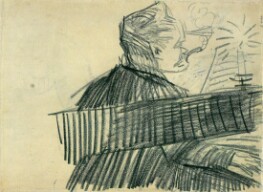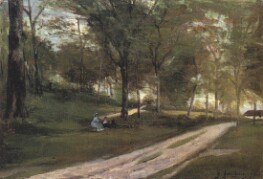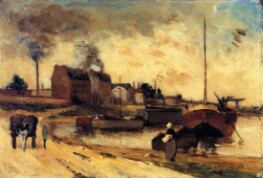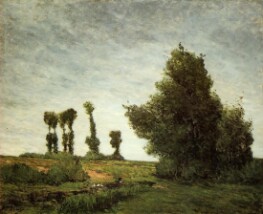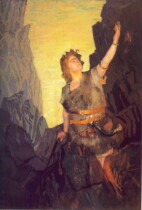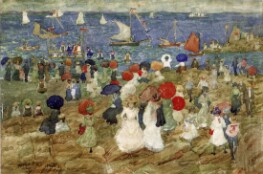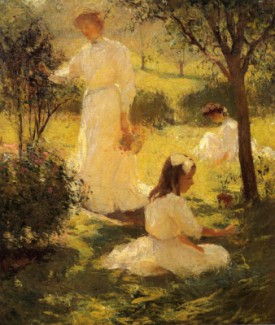The Vision after the Sermon (Jacob wrestling with the Angel)
Date: 1888 ; Pont-Aven , France in terms of modern geography
Art form: Painting
Dimensions: 74.4 X 93.1 cm (29.29 X 36.65 in)
One of the most famous works by Paul Gauguin, Vision After the Sermon: Jacob Wrestling with the Angel (1888) was painted during the artist's stay in Pont-Aven, Brittany. The painting refers to the biblical story of Jacob, who crossed the river Jabbok and spent the night wrestling a mysterious angel. The artist depicts the subject indirectly, showing a group of Breton women after a sermon in church. The women moved by the sermon see a vision of Jacob wrestling the angel.
The available information about the painting comes primarily from two sources: letters written by Gauguin and writings by Post-Impressionist artist Emile Bernard. Bernard spent the summer of 1888 with Gauguin in Pont-Aven – the two worked side by side, and while Gauguin painted Vision After the Sermon Bernard worked on the painting Breton Women in the Meadow (1888). The two paintings share stylistic similarities and are both examples of Cloisonnism – a post-impressionist style characterized by bold flat forms enclosed by dark outlines. Both artists also shared an affinity for Japanese art, and Bernard wrote that the motif of Jacob wrestling the angel in Vision After the Sermon was modeled after Hokusai’s Sumo Wrestlers.
Gauguin used the term Synthetism to describe paintings such as Vision After the Sermon, in which he aimed to synthesize between the outward appearance of the subject, the artist’s emotional response to the subject, and the aesthetic considerations of line, form, and color. In Vision After the Sermon, Gauguin creates a synthesis between two realities: the everyday life of the Breton women and their vision of the biblical event. In a letter to Vincent Van Gogh, he wrote about the sermon that inspired the painting: “For me, the landscape and the fight only exist in the imagination of the people praying after the sermon which is why there is a contrast between the life-size people and the struggle in its non-natural disproportionate landscape”. For this reason, Gauguin emphasized the contrast between the dramatic fight scene and the serenity of the women quietly praying.
By weaving together different Christian symbols, Gauguin added new content and meaning to the religious subject. In the foreground, he depicted twelve Breton women in prayer, a symbolic reference to Jacob’s twelve sons, the predecessors of the twelve tribes of Israel. The apple tree in the center of the composition was another non-traditional addition to the story of Jacob. In the bible, the apple tree is a symbol of knowledge, a reference to man’s awakening, and subsequently his fall from grace. In Vision After the Sermon, the apple tree is full and lush, suggesting the possibility of man’s redemption and a possible return to paradise. Another important component is the bull emerging from the left corner of the painting. The bull is possibly a sacrificial animal, and as such, it can hint to the sacrifice of Christ and the chance for redemption. The bull is also connected to Breton, it is a symbol attributed to four Breton saints. In this way, Gauguin formed a connection between his unique symbolism and the spirituality of the devout Breton women.
